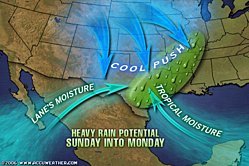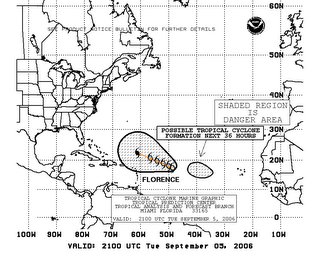
Hurricane Lane slammed into the western Mexican coast at Mazatlan as a Category 3. The storm quickly degenerated and is now only a tropical depression. The moisture from Lane is being carried into south Texas and is interacting with a fairly strong cold front resulting in some very heavy thunderstorms over southeast Texas and southwest Louisiana. Tropical moisture moving onshore from the Gulf adds additional moisture resulting in high humidity and fueling the storms with plenty of moisture.
Heavy rain is possible throughout Sunday night and all day Monday and Monday evening. Many areas in central Texas that have been under severe drought warnings are now under flood watches as too much rain is falling at once.
Lane began by following the storm path of Hurricane John which had caused a great deal of destruction along Baja California.

As the storm strengthened, it turned eastward and came ashore into the mainland area of Mexico at Mazatlan.
Forming right alongside Lane is Tropical Storm Miriam. It looks like Miriam will avoid land and is expected to weaken fairly quickly.
In the Atlantic, it is looking like there will be a One-two-three striker with Hurricanes Gordon and Helene essentially following the same pathway as Hurricane Florence. Fortunately, Gordon missed the island altogether and I certainly hope the same happens with Helene.
I have been suspecting that Hurricane Helene will continue its predicted turn towards the north and will pass by Bermuda. However, the predictions continue to move the cone of uncertainty to the west and now the chance of at least tropical storm strength winds affecting Bermuda seems more likely. Helene is a Category 2 storm right now and may continue to strengthen. If strengthening continues and the predicted path continues to shift westward, Bermuda may be affected by a severe hurricane. We will have to keep a close eye on Helene now where earlier in the week it seemed as if both Gordon and Helen would be a concern only to shipping lanes. Now it seems as if that is not necessarily the case.

Gordon became the first storm of the year to reach a severe storm status (Cat 3) but quickly weakened in the cooler waters. The same scenario is expected for Helene but if the storms path brings it really close to Bermuda then the situation could change significantly.
 TD #9 has formed into Tropical Storm Issac. Once again we have a storm in the central Atlantic that will follow the same pathways away from the east coast of North America and head towards the northern areas of the oceans and possibly Europe.
TD #9 has formed into Tropical Storm Issac. Once again we have a storm in the central Atlantic that will follow the same pathways away from the east coast of North America and head towards the northern areas of the oceans and possibly Europe.




















